Capita Mercury Review
The Capita Mercury is a slightly set back, all terrain board that is lightweight, fast and really fun wherever I rode it. It is on the higher end, more expensive set of Capita boards, but I think this one is worth it, for my style of riding.
Features of the Capita Mercury
Resort V2 Profile
There is a traditional camber section for most of the board, with reverse camber on the nose and tail. The camber section keeps it stable and poppy, and the reverse camber section helps with float in deep snow.

6.5/10 Flex
Capita give the Mercury a rating of 6.5 out of 10, though to me it feels stiffer.
FSC Certified Panda Core
Based on the P2 Superlight core, which is made up of an even mix of Poplar and Paulownia wood, to get a balance between pop while still having a smooth flex. The Panda Core version saves some weight and adds extra pop by adding two Bamboo Power Rods. It is FSC (Forest Stewardship Council) certified, which means that the wood comes from managed forests that, have sustainable harvest levels and quick regeneration.
Amplitex V-Tech Amplifier
These are a mix between a natural flax fiber, that is woven with carbon strands. The carbon is strong and reactive, and the flax is lightweight and damp (absorbs vibrations). They are only found on the high end Capita boards.
Holysheet Triax/Triax Fiberglass
With a higher glass to weight ratio than normal fiberglass, it means that it is stronger and more responsive without being heavier.
Magic Bean Resin
Made up of 60% renewable, agricultural raw materials, it is plant based, and is made without waste or greenhouse emissions.
Hyperdrive Base
The fastest base that Capita make, that is a sintered material that has added carbon.
New Age Directional Sidecut with Death Grip
It is a progressive sidecut, with a small reverse arc that adds an extra contact point in the middle of the sidecut for extra grip. Only found on the Mercury.
Multitech Level 6 DeepSpace Silkscreen
PAM16000 Topsheet with Metallic Underlay
Die-Cut Base
Saves on waste, for example one board will have a mainly black base with white logo, while the next board will have a mainly white base with black writing.
PLT Topsheet Technology
360 Degree HRC48 Steel Edges
Steel edges that run the whole way around the board.
Full ABS1000 Sidewalls
Stainless Steel 4 x 2 Inserts
Plain old regular inserts. You can mount any 4×4 or 4×2 bindings on this board.
How the mercury Rides
Board size: 157cm
Boots: Salomon Launch Boa SJ 27.5 / Vans Infuse / Burton Photon Step On
Bindings: Burton Cartel / Step On X
This review is based on me riding the 157cm 2020 model. I bought the Mercury without testing it, but I had only heard good things about it from people who have similar riding styles to me, so I was fairly confident that I would like it. I was looking to get a new board to replace my regular daily board, the Salomon Ultimate Ride. There was nothing wrong with it, just time for a change.
I’ve been riding this in BC, Canada, in everything from fresh deep powder, to hard-packed and windblown snow and ice. So far I would have around 60-70 days of riding on it.
Camber Profile
The Resort V2 Profile is a pretty good option for a do it all board, and has a good balance of rocker and camber. Coming from a (almost) full camber board, I was interested to see how this would ride, as I am used to a pretty long effective edge, and a very stable feel. Even though I was riding a longer size Mercury than I regularly ride (157 instead of 155), it still has a decent and solid feel. With the rocker nose and tail, less of the actual board touches when you are riding on hard-packed snow, so it still feels easy to move around, while still being stable.
Flex and Pop
The Mercury has a medium flex rating, that Capita rate as a 6.5/10. Of course that only applies if you are within the recommended weight ranges, and for the 157cm they have a weight guide of 59-86kg, and I weigh 72kg, so I am right in the middle of their range. The medium flex suits my riding really well, it is definitely stiff enough to be able to charge through chopped up powder and rough terrain, without feeling like a stiff plank. The pop is really good, better than I would expect for a board with rocker in nose/tail. It flexes nicely, and pushes back strongly with a nice snap.
Edge Hold
The edge hold is pretty good, not as reliable or “grippy” as a full camber board, but still quite good. I can still ride fast into a turn and be confident it will hold without a problem. In the middle of the sidecut there is the “Death Grip” little bump, which is hard to see unless you look directly down the sidecut, but I assume that it is helping give some extra edge hold.
Float
The Mercury has pretty decent float for a board that isn’t too far off a twin board. The reverse camber nose does give a little lift in deep snow, and if you lean back just a little bit you get a nice surfy feel without much effort.
Speed
Easily one of the best features of the Mercury is the speed. The base is one of the better options from Capita, and it has been nice and quick in all the conditions I have ridden it in. It soaks up wax well, and performs like you would expect from a fairly expensive board.
Pros:
- Fast base
- Lightweight
- Nice medium to stiff flex
- Useful all terrain camber profile
Cons
Overall
Overall, I have been super happy with the Mercury. It has quickly taken the place as my daily board, it does well everywhere. The only thing I haven’t ridden it on is rails, as I don’t know if I want to detune it yet – or at all. Jumps, carving, powder, it does it all nicely.
Really there wasn’t any major cons to the board, but it is a fairly expensive one. The camber profile and core gives enough edge hold and grip for aggressive riding, but the rocker nose and tail mean that it doesn’t have a full on feel like a traditional camber board, so you can be lazy and messy without it catching. It definitely isn’t a beginners board, but if you are an intermediate or better rider, you could probably get quite a lot out of this board.
Being an all-terrain board, there has to be tradeoffs somewhere, and I think that the balance is just about as good as it can get with the Mercury. Enough camber for hard snow, enough rocker for deep snow, enough flex to be fun and reliable without being too stiff, I think it is going to stay as my main board from now on.
After a few years, I haven’t really changed my mind on the Mercury at all. If anything I think it is better than ever. I haven’t been nice to my 157, and it has held up great overall. I normally rotate through a lot of boards, buying and selling to always try something new. I haven’t even considered getting rid of the Mercury, as there isn’t anything that I think that would replace it – but we will see.
Where does the Mercury sit in the Capita Line?
Outerspace Living
- 5/10 Flex
- Resort V3 Profile
- Multizone Core
- 0.5″ setback
- Superdrive FX Base (slower)
- $449.99
The Outerspace Living is basically just a cheaper, softer Mercury. The profile is very similar to the Mercury, but has regular curved tips rather than flat. It has a slower but cheaper base. Narrower waist widths which will speed up edge to edge feel, but make sure to get a wide model if you have big boots.
Read moreMercury
- 6.5/10 Flex
- Resort V2 Profile
- Hover Core
- 0.5″ setback
- Traction Tech 2.0
- Hyperdrive Base
- $599.99
Mega Merc
- 6.5/10 Flex
- Resort V2 Profile
- 3D Thermopolymer Starship Core
- 0.5″ setback
- Traction Tech 3.0
- Hyperdrive Base
- $799.99
The version for those with plenty of spare money. Same camber profile and measurements as the regular Mercury, but with an very different core, carbon and topsheet which makes it much lighter.
Read moreWhat are similar boards like the Mercury from other brands?
Jones Mountain Twin
Very similar overall, the biggest difference is that the Jones has 3D Base Contour, which means that the nose and tail have some 3d shaping. Read more about the Mountain Twin.
Yes Standard
Quite similar specs overall, though the Standard does have a bit more volume (float), and with the MidBite shape still has a regular waist width. Read more about the Yes Standard.
Capita Mercury Technical Specs
| Length | Effective Edge (cm) | Nose/Tail Length (cm) | Waist Width (cm) | Sidecut (m) | Weight Range (lbs) | Weight Range (kg) |
| 153 | 115.3 | 29.6 | 25.3 | 7.50/1.50/7.50 | 100-160 | 45-72 |
| 155 | 116.9 | 29.9 | 25.5 | 7.70/1.50/7.70 | 120-180 | 54-81 |
| 157 | 118.5 | 30.1 | 25.7 | 7.85/1.50/7.85 | 130-190 | 59-86 |
| 159 | 120.1 | 30.3 | 25.9 | 8.00/1.50/8.00 | 140-200 | 63-90 |
| 161 | 121.7 | 30.6 | 26.1 | 8.15/1.50/8.15 | 160-220+ | 72-99+ |
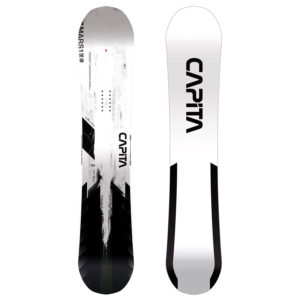
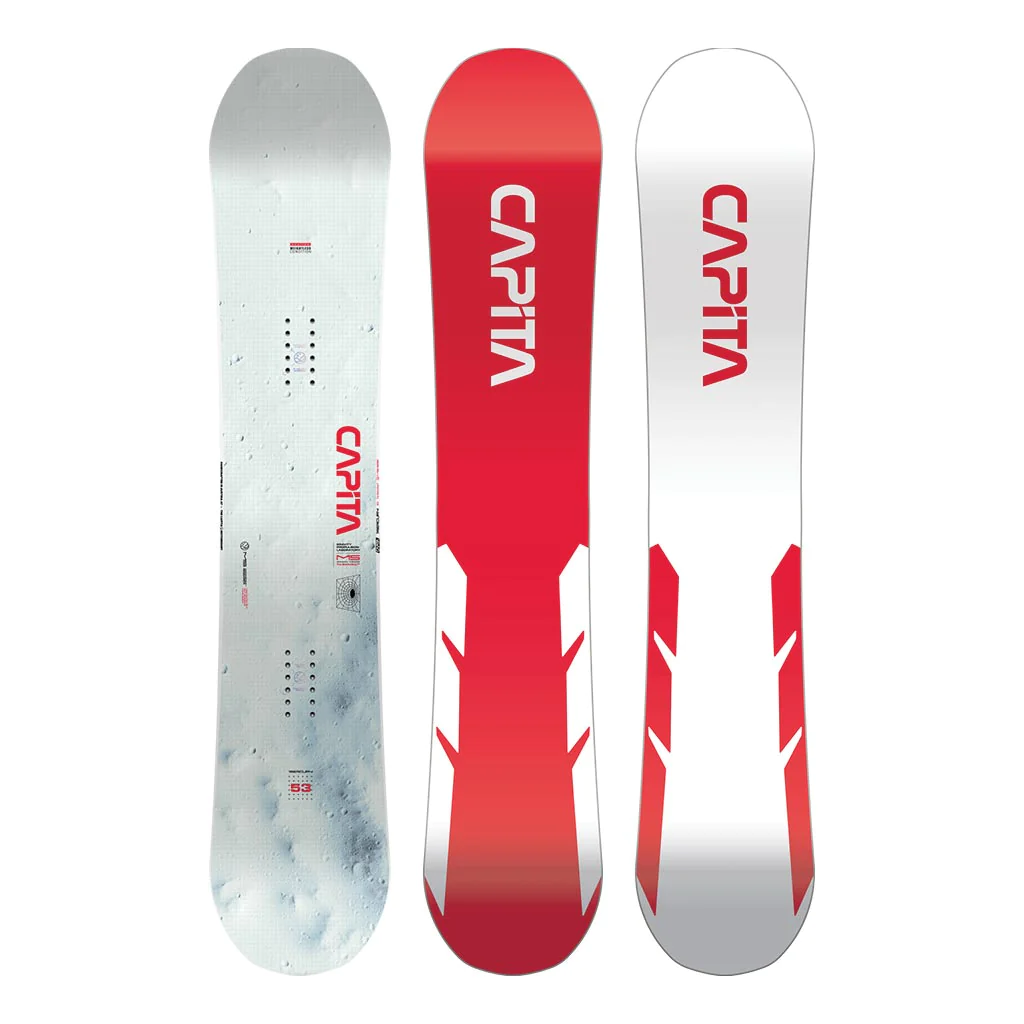
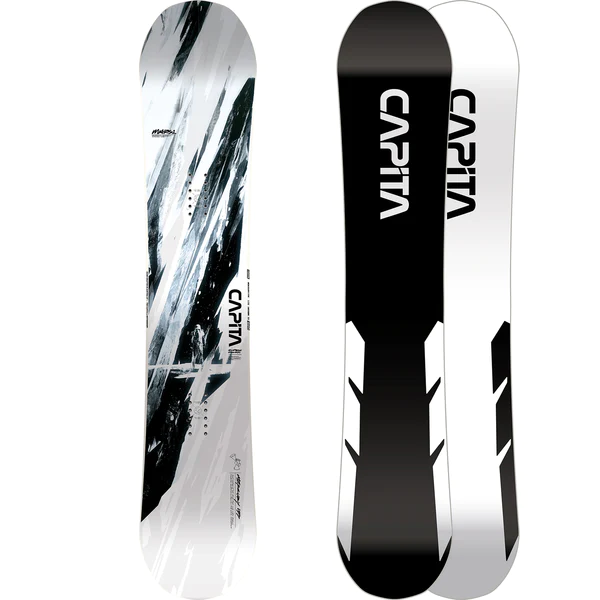
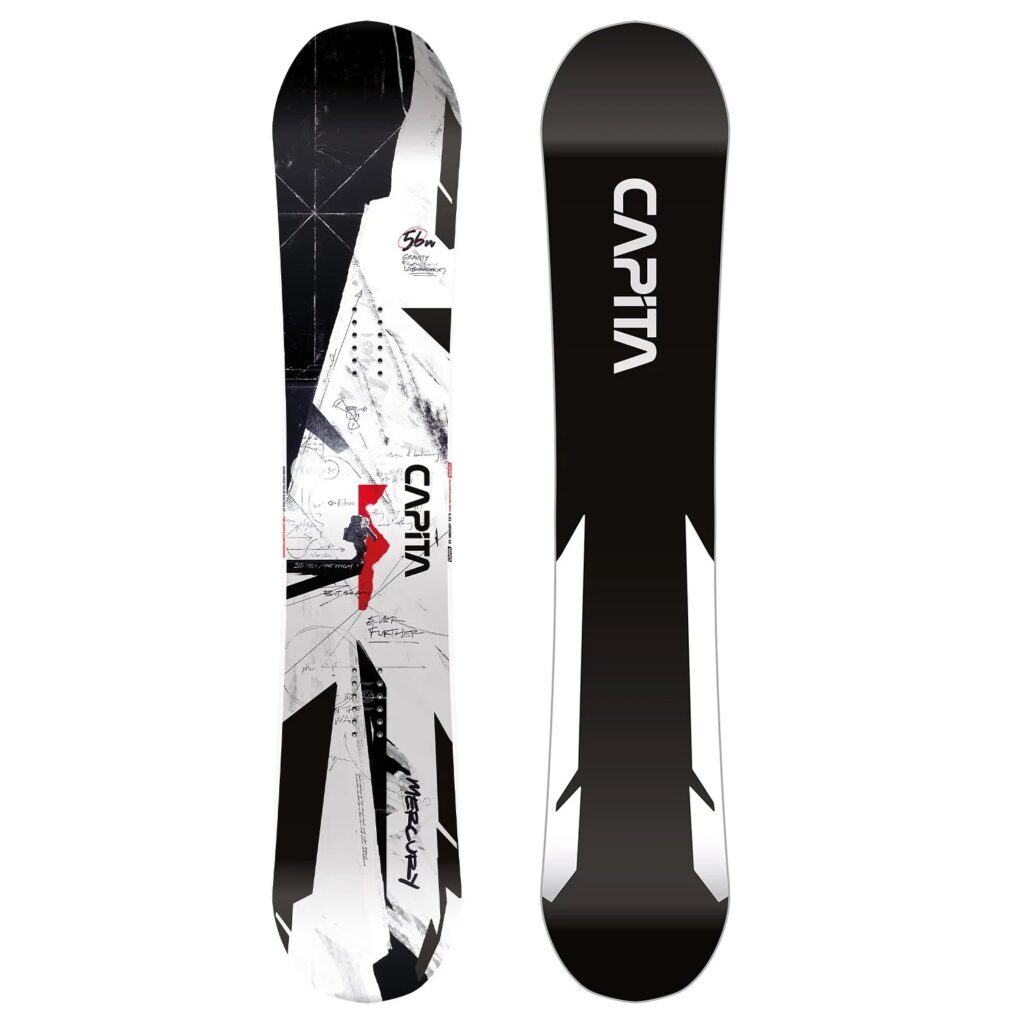
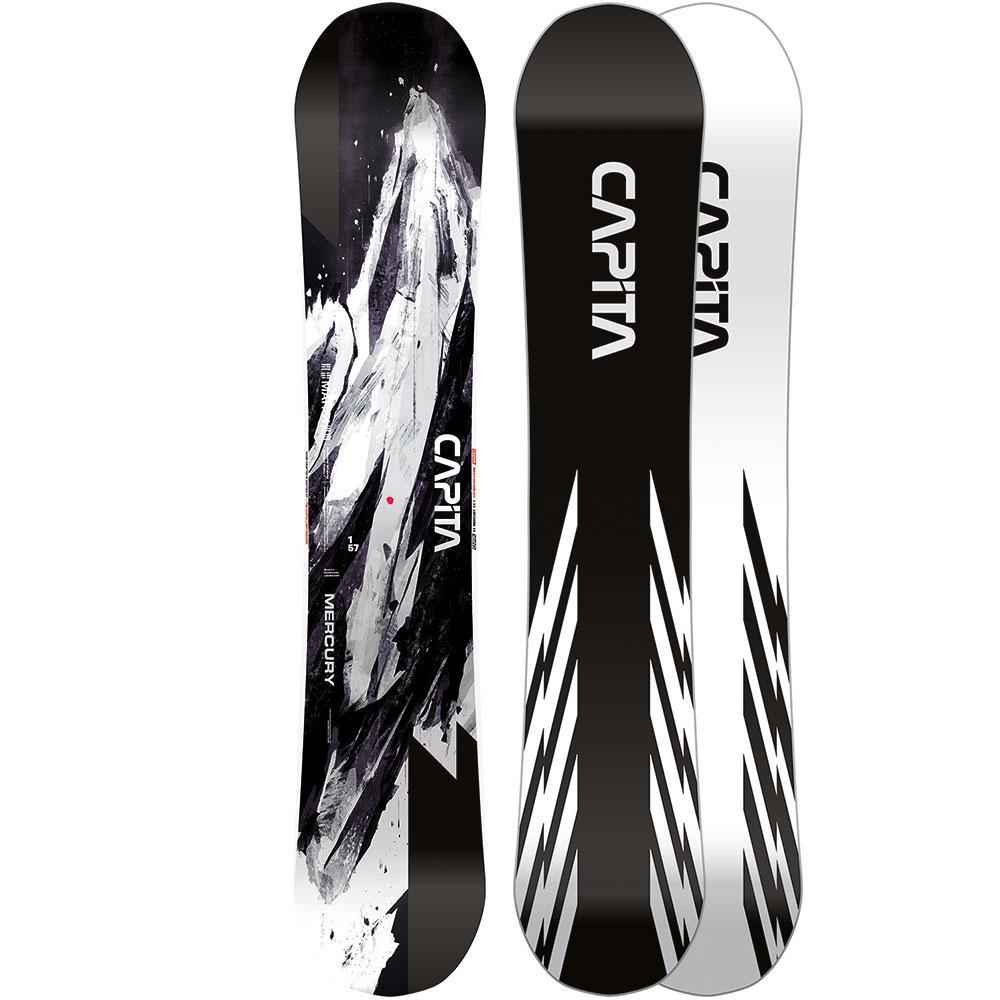
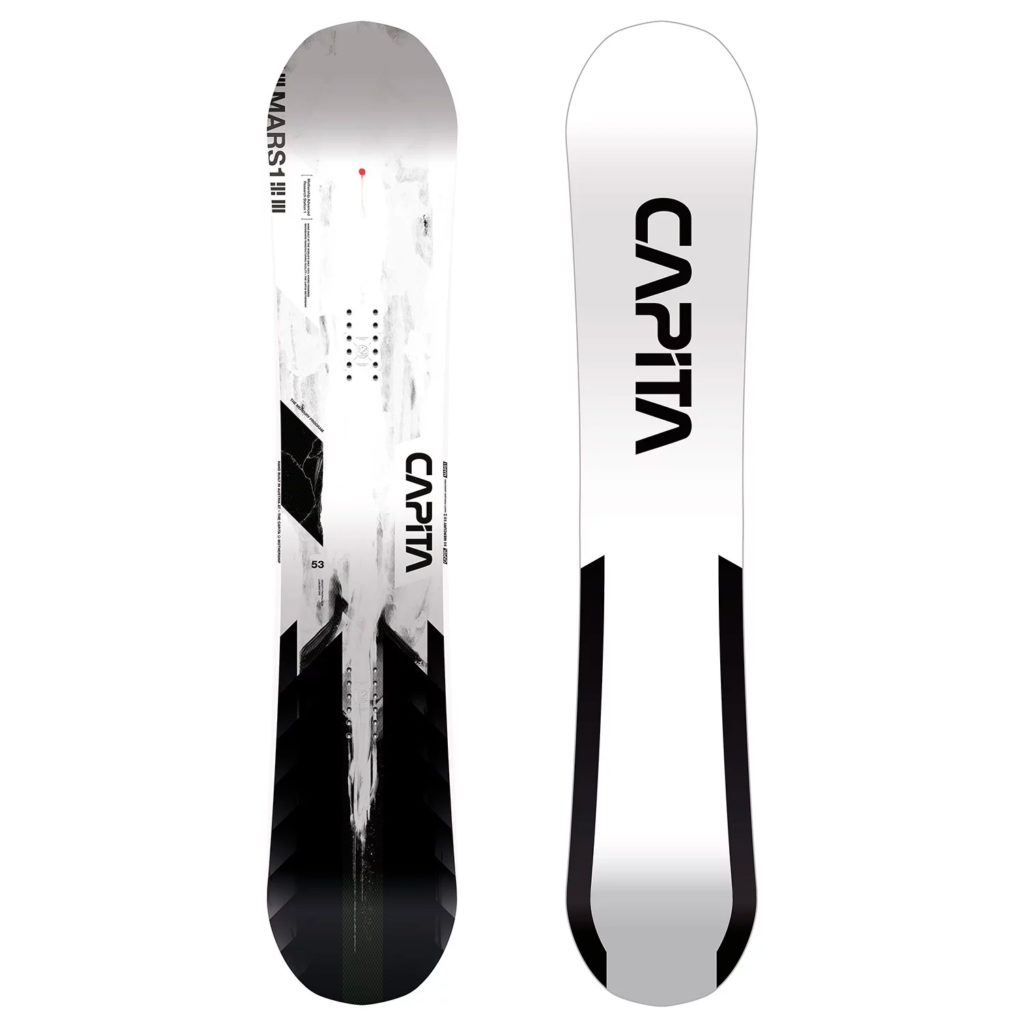
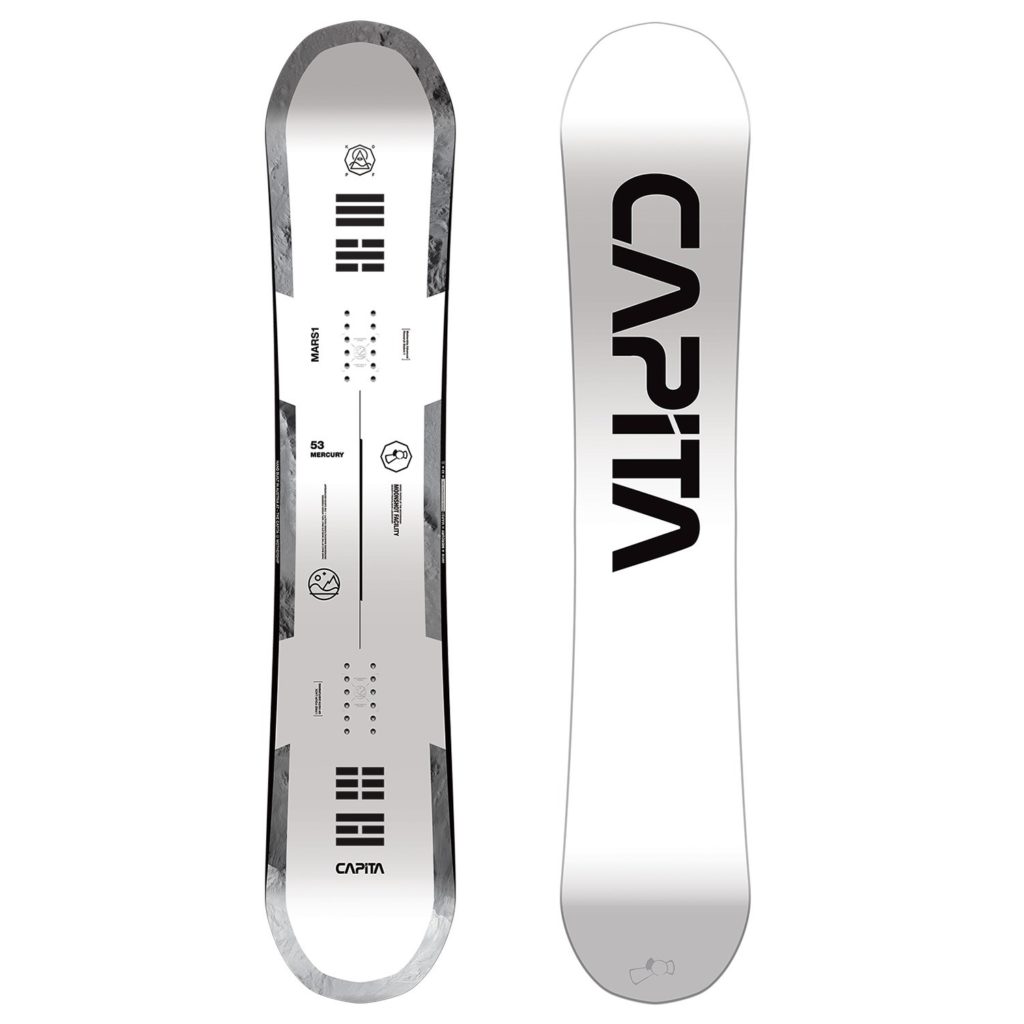
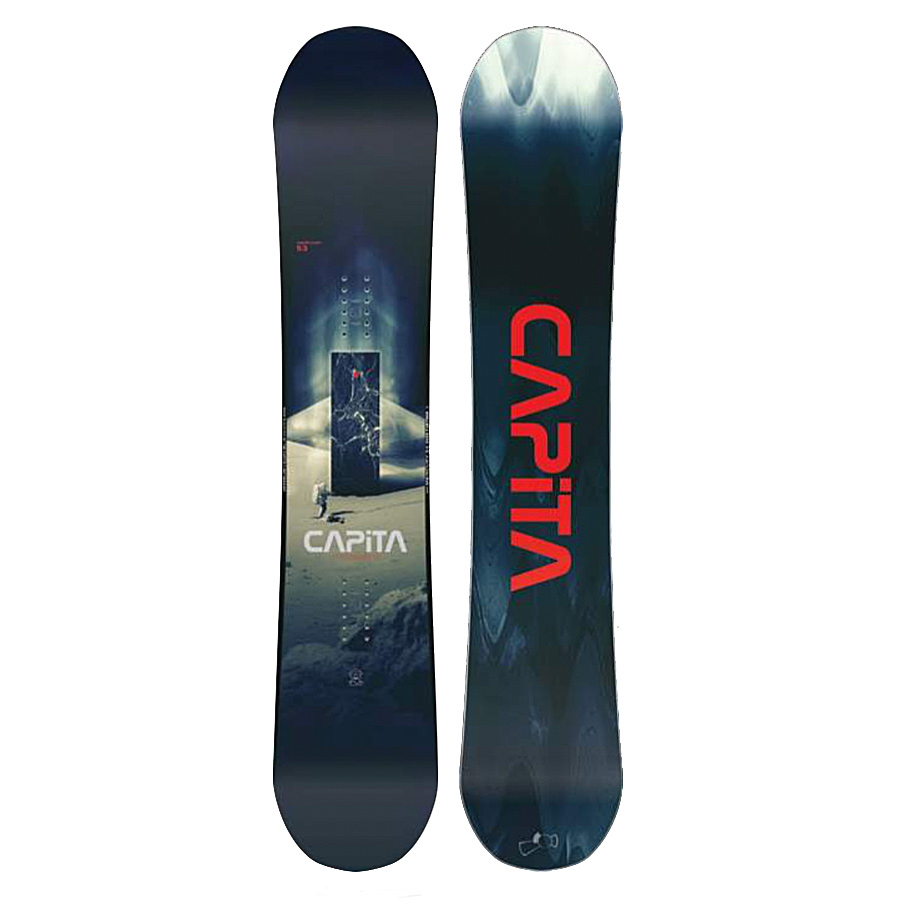
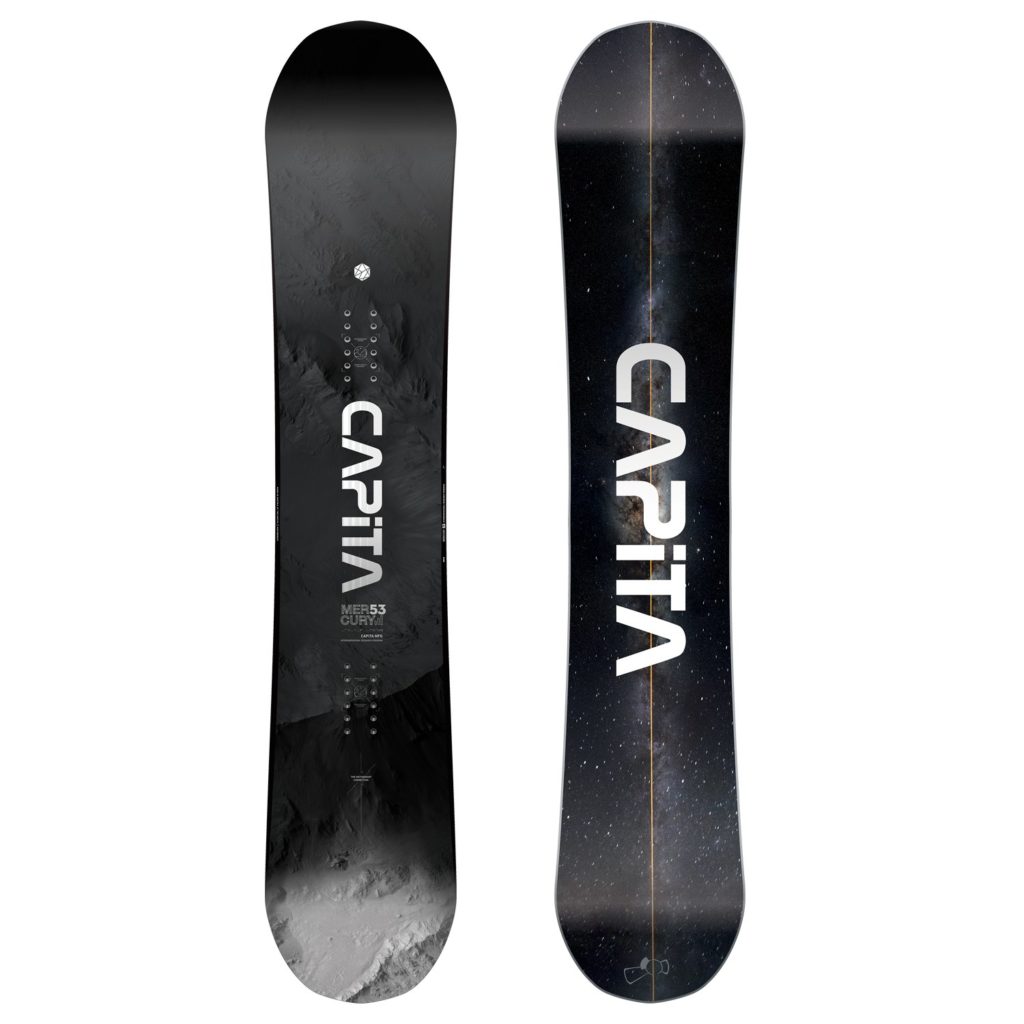
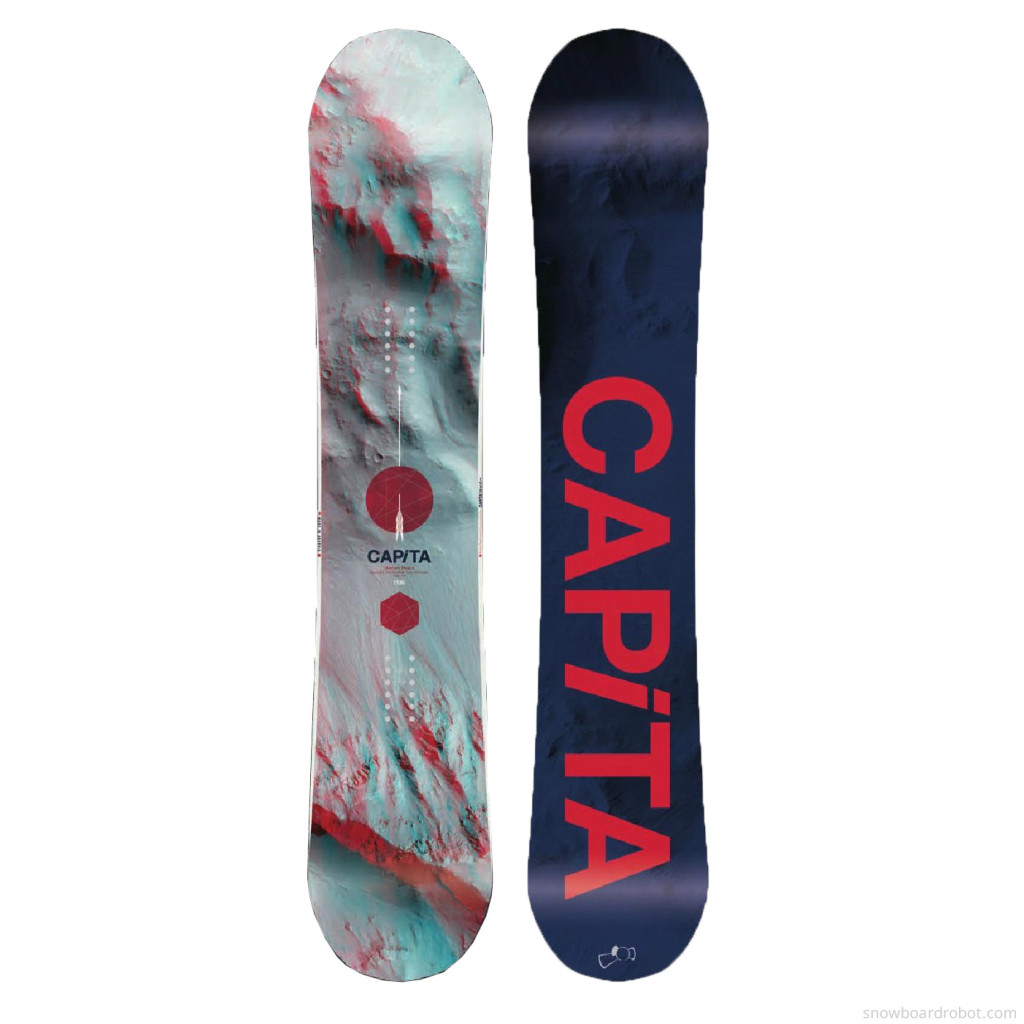
Hola ! I’m glad to hear at you like it the Mercury ! Like we talk the last time ! ( azymulator ) I got this two boards too ! Last year I ride the Mercury 155 I’m 75 kg but I felt the side cut I little bit too short and after 2 feet snow needs more float ! That’s why I get the 157 this year ! Is in plastic waiting for the perfect day to rip ! By the time I’m riding Bataleon ( Goliath , Evil twin , party way by now ) this last board party wave from Bataleon you got to review this one as a second quiver board ! Is super super fun to ride , carving ,,,o got this one on 151 but if you ride bigger mountains like BC May need 154 , I have not testing this board in pow ! May be a fun pow board for the dimensions side cut radius 9.0 and 28 cm wide , wow !!! And that wide nose open de pow ????, TBT tech make it feel like lose and not so gripi like the Warpig at the same size ! That also ride it for 3 days ……! Check this deck ! Bataleon party wave you will love it ! It’s a board that always has to be in the back sit of your car just in case !!! ❤️
Hey,
I’m 6’1 lightweight at 160lb. I usually ride 15/-15 duck stance. I’ve been eyeing this board but with my weight should I go for 155 or 157? One other factor is that I have Burton Mission Large bindings and a size 10.5 burton boa boot. I want to be able to carve and not clip my heel/toe. I don’t do any park or anything, just powder and groomers. Your insight would be helpful, would consider different board on your recommendation too.
It would depend on what terrain you like to ride most – I ended up getting the 157 because I wanted it to do well in powder, but I would have gone for a 155 if I was going to ride it in the park more.
The waist width on both the 155 and the 157 is going to be fine with your boots, you might just have to push the Large bindings forward to get a good toe/heel balance with your boots.
I would go for the 157 if I were you, I found it to be great in powder, and carve really well on groomers, I don’t really think I would have really found any advantages going any shorter.
Hello,
I’m having a hard time deciding if I should buy the 157 or 159 Mercury. I currently have a Yes Jackpot 154 for park and an Arbor Annex 159 for freeriding. I’m 6’0, 190 lbs, and wear size 10 boots. I’m looking for a quiver of one board that will allow me to ride switch, powder, butter, carve, steeps, tight trees, side hits, and small to medium jumps. Which size would you recommend? Any advice would be greatly appreciated.
I think that the 157 would be the best all around choice. If you just wanted the Mercury for freeriding, powder and carving the bigger 159 would be best, but for tight trees and the park going a touch smaller would be better.
Size for all mountain — groomers + pow?
6 foot
210lbs
Size 9.5 boot
Burton cartel bindings
It would be between the 157 and the 159, go for the bigger if you want a more stable feel and better float in powder, or shorter if you aren’t always charging and want a board that is a bit easier to move around.
Hey Lachy, how does the Mercury compare with the T. Rice Pro? Are they similar?
I haven’t ridden the T.Rice in a long time, but they are going to have a very different ride – mainly because they have opposite profiles. The Mercury with camber between the feet and rocker on the ends, while the T.Rice has rocker between your feet and camber on the ends.
In general I prefer camber between the feet, but until I ride the new T.Rice I wouldn’t be able to say for sure.
Hi
i`m trying to decide between the mercury and the yes standard
I`m 6`2 195 pounds size 11 boot ( adidas with small footprint)
I like to jump small/medium features, ollie everything, spin 180s , an occasional 3 , and i butter a lot, All this i do chasing pow or on sidehits
So i`m looking for a board i can play with but also not fight to keep it floating in pow,
Are you familiar with the yes standard to give me some insight between these two? or if you have another board in mind i`m open to suggestions
Thank you
I haven’t ridden the Yes Standard yet, but it looks like the advantage to is would be the overall wider width for float in powder. Other than that the specs look fairly similar to the Mercury. The flex on both boards will need a bit of effort to butter, but you can get used to that pretty quickly. I think it is easy to recommend the Mercury, but I can’t give a good comparison to the Standard yet.
Love your review of the Mercury, picked one up for this season and it absolutely rips. Semi-related – what are you thoughts on the boots you wore? The Salomon Launch BOA SJ. I got those last year, and they’re super comfortable…however my feet are wet after about half a day of riding. Have you had a similar experience?
Thanks! I haven’t had any major issues with them being wet, and am on my third pair of them now. The current pair I have I will put on the boot dryer when I get home, but I am also riding long days now in warm/wet Whistler weather, so I think they are just getting sweaty, not that they are leaking.
I would take the liners out one day after riding, and check to see if it is wet between the liner and the shell, if it is let that dry. Something like that could be making it worse if it never actually gets to dry properly.
Hey Lachy,
Can you do a review comparing the Mercury to the Ride Algorythm. Would love to hear your thoughts on this.
Thanks for the reviews.
For sure, I’ll see if I can find an Algorythm to ride.